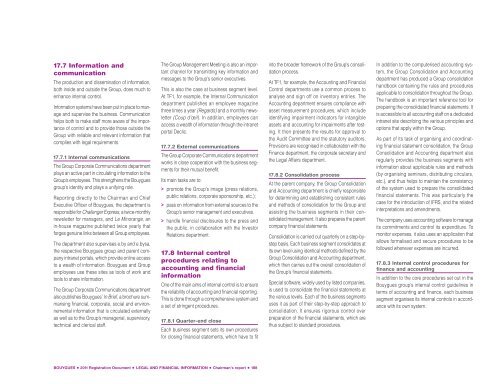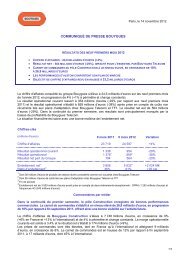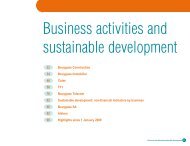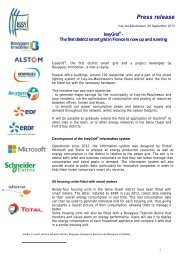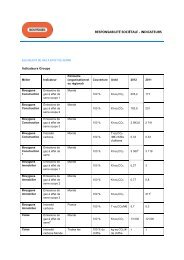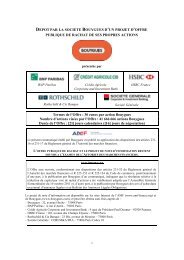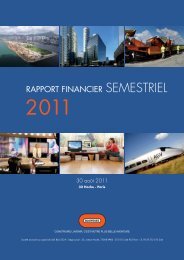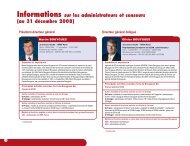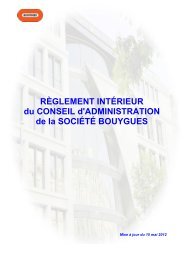Registration Document BOUYGUES
Registration Document BOUYGUES
Registration Document BOUYGUES
You also want an ePaper? Increase the reach of your titles
YUMPU automatically turns print PDFs into web optimized ePapers that Google loves.
17.7 Information and<br />
communication<br />
The production and dissemination of information,<br />
both inside and outside the Group, does much to<br />
enhance internal control.<br />
Information systems have been put in place to manage<br />
and supervise the business. Communication<br />
helps both to make staff more aware of the importance<br />
of control and to provide those outside the<br />
Group with reliable and relevant information that<br />
complies with legal requirements.<br />
17.7.1 Internal communications<br />
The Group Corporate Communications department<br />
plays an active part in circulating information to the<br />
Group’s employees. This strengthens the Bouygues<br />
group’s identity and plays a unifying role.<br />
Reporting directly to the Chairman and Chief<br />
Executive Officer of Bouygues, the department is<br />
responsible for Challenger Express, a twice-monthly<br />
newsletter for managers, and Le Minorange, an<br />
in-house magazine published twice yearly that<br />
forges genuine links between all Group employees.<br />
The department also supervises e.by and e.bysa,<br />
the respective Bouygues group and parent company<br />
intranet portals, which provide online access<br />
to a wealth of information. Bouygues and Group<br />
employees use these sites as tools of work and<br />
tools to share information.<br />
The Group Corporate Communications department<br />
also publishes Bouygues’ In Brief, a brochure summarising<br />
financial, corporate, social and environnemental<br />
information that is circulated externally<br />
as well as to the Group’s managerial, supervisory,<br />
technical and clerical staff.<br />
The Group Management Meeting is also an important<br />
channel for transmitting key information and<br />
messages to the Group’s senior executives.<br />
This is also the case at business segment level.<br />
At TF1, for example, the Internal Communication<br />
department publishes an employee magazine<br />
three times a year (Regards) and a monthly newsletter<br />
(Coup d’œil). In addition, employees can<br />
access a wealth of information through the intranet<br />
portal Declic.<br />
17.7.2 External communications<br />
The Group Corporate Communications department<br />
works in close cooperation with the business segments<br />
for their mutual benefit.<br />
Its main tasks are to:<br />
> promote the Group’s image (press relations,<br />
public relations, corporate sponsorship, etc.);<br />
> pass on information from external sources to the<br />
Group’s senior management and executives.<br />
> handle financial disclosures to the press and<br />
the public, in collaboration with the Investor<br />
Relations department.<br />
17.8 Internal control<br />
procedures relating to<br />
accounting and financial<br />
information<br />
One of the main aims of internal control is to ensure<br />
the reliability of accounting and financial reporting.<br />
This is done through a comprehensive system and<br />
a set of stringent procedures.<br />
17.8.1 Quarter-end close<br />
Each business segment sets its own procedures<br />
for closing financial statements, which have to fit<br />
into the broader framework of the Group’s consolidation<br />
process.<br />
At TF1, for example, the Accounting and Financial<br />
Control departments use a common process to<br />
analyse and sign off on inventory entries. The<br />
Accounting department ensures compliance with<br />
asset measurement procedures, which include<br />
identifying impairment indicators for intangible<br />
assets and accounting for impairments after testing.<br />
It then presents the results for approval to<br />
the Audit Committee and the statutory auditors.<br />
Provisions are recognised in collaboration with the<br />
Finance department, the corporate secretary and<br />
the Legal Affairs department.<br />
17.8.2 Consolidation process<br />
At the parent company, the Group Consolidation<br />
and Accounting department is chiefly responsible<br />
for determining and establishing consistent rules<br />
and methods of consolidation for the Group and<br />
assisting the business segments in their consolidated<br />
management. It also prepares the parent<br />
company financial statements.<br />
Consolidation is carried out quarterly on a step-bystep<br />
basis. Each business segment consolidates at<br />
its own level using identical methods defined by the<br />
Group Consolidation and Accounting department,<br />
which then carries out the overall consolidation of<br />
the Group’s financial statements.<br />
Special software, widely used by listed companies,<br />
is used to consolidate the financial statements at<br />
the various levels. Each of the business segments<br />
uses it as part of their step-by-step approach to<br />
consolidation. It ensures rigorous control over<br />
preparation of the financial statements, which are<br />
thus subject to standard procedures.<br />
In addition to the computerised accounting system,<br />
the Group Consolidation and Accounting<br />
department has produced a Group consolidation<br />
handbook containing the rules and procedures<br />
applicable to consolidation throughout the Group.<br />
The handbook is an important reference tool for<br />
preparing the consolidated financial statements. It<br />
is accessible to all accounting staff on a dedicated<br />
intranet site describing the various principles and<br />
options that apply within the Group.<br />
As part of its task of organising and coordinating<br />
financial statement consolidation, the Group<br />
Consolidation and Accounting department also<br />
regularly provides the business segments with<br />
information about applicable rules and methods<br />
(by organising seminars, distributing circulars,<br />
etc.), and thus helps to maintain the consistency<br />
of the system used to prepare the consolidated<br />
financial statements. This was particularly the<br />
case for the introduction of IFRS, and the related<br />
interpretations and amendments.<br />
The company uses accounting software to manage<br />
its commitments and control its expenditure. To<br />
monitor expenses, it also uses an application that<br />
allows formalised and secure procedures to be<br />
followed whenever expenses are incurred.<br />
17.8.3 Internal control procedures for<br />
finance and accounting<br />
In addition to the core procedures set out in the<br />
Bouygues group’s internal control guidelines in<br />
terms of accounting and finance, each business<br />
segment organises its internal controls in accordance<br />
with its own system.<br />
<strong>BOUYGUES</strong> • 2011 <strong>Registration</strong> <strong>Document</strong> • LEGAL AND FINANCIAL INFORMATION • Chairman's report • 188


